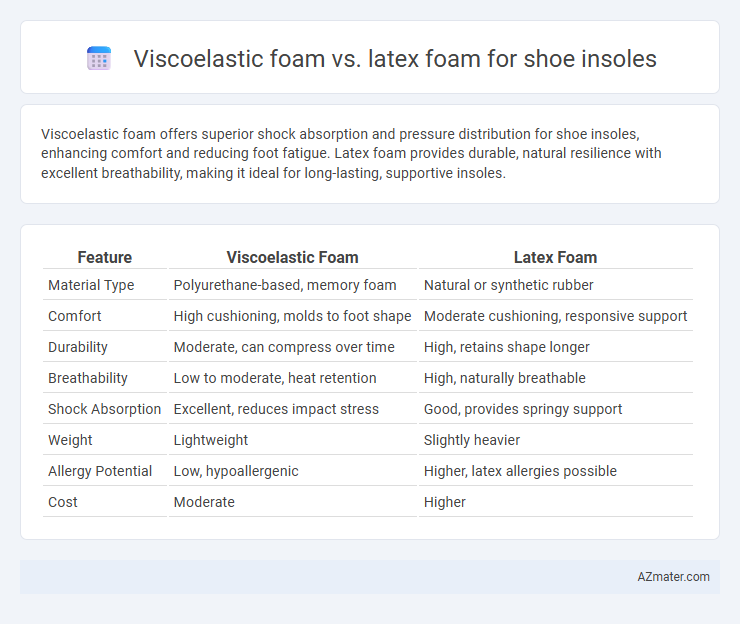Viscoelastic foam offers superior shock absorption and pressure distribution for shoe insoles, enhancing comfort and reducing foot fatigue. Latex foam provides durable, natural resilience with excellent breathability, making it ideal for long-lasting, supportive insoles.
Table of Comparison
| Feature | Viscoelastic Foam | Latex Foam |
|---|---|---|
| Material Type | Polyurethane-based, memory foam | Natural or synthetic rubber |
| Comfort | High cushioning, molds to foot shape | Moderate cushioning, responsive support |
| Durability | Moderate, can compress over time | High, retains shape longer |
| Breathability | Low to moderate, heat retention | High, naturally breathable |
| Shock Absorption | Excellent, reduces impact stress | Good, provides springy support |
| Weight | Lightweight | Slightly heavier |
| Allergy Potential | Low, hypoallergenic | Higher, latex allergies possible |
| Cost | Moderate | Higher |
Introduction to Viscoelastic and Latex Foams
Viscoelastic foam, known for its slow recovery and pressure-relieving properties, adapts closely to foot contours, offering optimal cushioning for shoe insoles. Latex foam, derived from natural or synthetic sources, provides resilient, springy support with excellent breathability and durability suitable for prolonged wear. Both materials enhance insole comfort but differ fundamentally in responsiveness and moisture management.
Material Composition and Structure
Viscoelastic foam, commonly known as memory foam, consists of polyurethane with added chemicals that increase its viscosity and density, allowing it to contour closely to the foot by responding to heat and pressure. Latex foam is derived from natural or synthetic rubber and features an open-cell structure that provides resilience, breathability, and bounce-back support. The viscoelastic foam's slow recovery offers superior pressure redistribution, while latex foam's elastic matrix offers durable, responsive cushioning ideal for dynamic foot movement.
Cushioning and Comfort Comparison
Viscoelastic foam offers superior cushioning by conforming closely to foot contours, providing personalized pressure relief and shock absorption ideal for long hours of wear. Latex foam delivers a more resilient, responsive feel with excellent breathability, promoting natural foot movement and reducing heat buildup. Both materials enhance comfort, but viscoelastic foam excels in pressure distribution, while latex foam supports dynamic support and durability in shoe insoles.
Durability and Longevity
Viscoelastic foam insoles offer excellent shock absorption and contour to the foot but tend to compress and degrade faster under continuous use, reducing their durability over time. Latex foam insoles provide superior resilience and maintain their shape longer, exhibiting enhanced durability and longevity in high-impact conditions. For shoe insoles requiring sustained support and durability, latex foam generally outperforms viscoelastic foam in maintaining performance and structural integrity.
Breathability and Moisture Management
Viscoelastic foam insoles offer excellent cushioning but typically have lower breathability and moisture management compared to latex foam, which provides superior airflow due to its open-cell structure. Latex foam's natural resilience allows for enhanced ventilation, reducing heat and moisture buildup, thereby promoting a cooler and drier environment inside the shoe. Breathable latex foam insoles help prevent odor and fungal growth more effectively than denser viscoelastic foam materials.
Shock Absorption Performance
Viscoelastic foam outperforms latex foam in shock absorption due to its higher energy dissipation and slower rebound characteristics, effectively reducing impact forces during walking or running. Latex foam provides moderate cushioning with quicker responsiveness but less capacity to absorb repetitive shocks over time. Viscoelastic materials, commonly found in memory foam insoles, offer superior pressure distribution enhancing comfort and minimizing foot fatigue compared to natural latex options.
Allergen Potential and Skin Sensitivity
Viscoelastic foam insoles often have lower allergen potential due to their synthetic materials, which are less likely to trigger common latex allergies. Latex foam insoles, derived from natural rubber, can cause allergic reactions in individuals sensitive to latex proteins, increasing the risk of skin irritation and dermatitis. Selecting viscoelastic foam is generally safer for users with skin sensitivity or known latex allergies, ensuring better comfort and reduced risk of allergic responses.
Weight and Flexibility Differences
Viscoelastic foam insoles are generally heavier due to their dense, slow-recovering structure, providing superior cushioning and pressure relief, while latex foam insoles are lighter with a more elastic, quicker recovery, enhancing flexibility and responsiveness. The weight difference influences overall shoe comfort, with latex foam offering a more lightweight feel suitable for dynamic movement. Flexibility in latex foam allows for better adaptability to foot movements, whereas viscoelastic foam provides more firm support but less adaptability.
Environmental Impact and Sustainability
Viscoelastic foam insoles, often made from petroleum-based polyurethane, tend to have a higher environmental footprint due to non-renewable resource extraction and limited biodegradability. Latex foam insoles, especially those derived from natural rubber, offer greater sustainability with renewable sourcing and improved biodegradability, reducing landfill impact. Choosing natural latex significantly supports eco-friendly shoe manufacturing by lowering greenhouse gas emissions and chemical pollutants compared to synthetic viscoelastic alternatives.
Choosing the Right Foam for Your Shoe Insoles
Viscoelastic foam offers superior shock absorption and pressure relief, making it ideal for reducing foot fatigue during extended wear, while latex foam excels in breathability and durability, providing natural moisture-wicking and long-lasting support. Selecting the right foam for your shoe insoles depends on your activity level, foot structure, and specific comfort needs, with viscoelastic foam preferred for cushioning and latex foam favored for responsiveness and ventilation. Consider factors such as arch support requirements, sweat management, and impact protection to ensure optimal foot health and comfort.

Infographic: Viscoelastic foam vs Latex foam for Shoe insole
 azmater.com
azmater.com